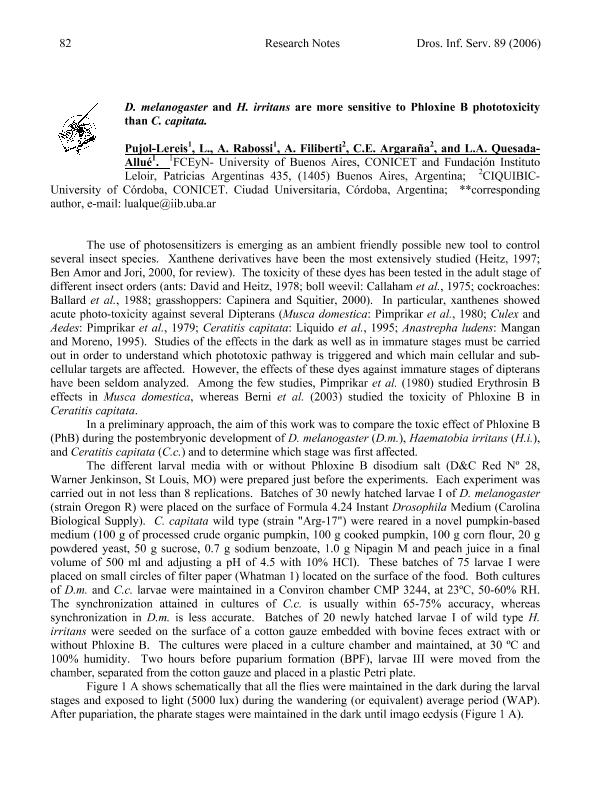Artículo
D. melanogaster and H. irritans are more sensitive to Phloxine B phototoxicity than C. capitata
Pujol Lereis, Luciana Mercedes ; Rabossi, Alejandro
; Rabossi, Alejandro ; Filiberti, Adrian
; Filiberti, Adrian ; Argaraña, Carlos Enrique
; Argaraña, Carlos Enrique ; Quesada Allue, Luis Alberto
; Quesada Allue, Luis Alberto
 ; Rabossi, Alejandro
; Rabossi, Alejandro ; Filiberti, Adrian
; Filiberti, Adrian ; Argaraña, Carlos Enrique
; Argaraña, Carlos Enrique ; Quesada Allue, Luis Alberto
; Quesada Allue, Luis Alberto
Fecha de publicación:
12/2006
Editorial:
University of Oklahoma
Revista:
Drosophila Information Service
ISSN:
0070-7333
e-ISSN:
0070-7333
Idioma:
Inglés
Tipo de recurso:
Artículo publicado
Clasificación temática:
Resumen
The use of photosensitizers is emerging as an ambient friendly possible new tool to control several insect species. Xanthene derivatives have been the most extensively studied (Heitz, 1997; Ben Amor and Jori, 2000, for review). The toxicity of these dyes has been tested in the adult stage of different insect orders (ants: David and Heitz, 19 78; boll weevil: Callaham et al., 1975; cockroaches: Ballard et al. , 1988; grasshoppers: Capinera and Squitier, 2000). In particular, xanthenes showed acute photo-toxicity agai nst several Dipterans ( Musca domestica : Pimprikar et al. , 1980; Culex and Aedes : Pimprikar et al. , 1979; Ceratitis capitata : Liquido et al. , 1995; Anastrepha ludens : Mangan and Moreno, 1995). Studies of the effects in the dark as well as in immature stages must be carried out in order to understand which phototoxic pathway is triggered and which main cellular and sub- cellular targets are affecte d. However, the effects of these dyes against immature stages of dipterans have been seldom analyzed. Among the few studies, Pimprikar et al. (1980) studied Erythrosin B effects in Musca domestica , whereas Berni et al. (2003) studied the toxic ity of Phloxine B in Ceratitis capitata.
Palabras clave:
Drosophila Melanogaster
,
Haematobia Irritans
,
Phloxine B
,
Ceratitis Capitata
Archivos asociados
Licencia
Identificadores
Colecciones
Articulos(IIBBA)
Articulos de INST.DE INVEST.BIOQUIMICAS DE BS.AS(I)
Articulos de INST.DE INVEST.BIOQUIMICAS DE BS.AS(I)
Citación
Pujol Lereis, Luciana Mercedes; Rabossi, Alejandro; Filiberti, Adrian; Argaraña, Carlos Enrique; Quesada Allue, Luis Alberto; D. melanogaster and H. irritans are more sensitive to Phloxine B phototoxicity than C. capitata; University of Oklahoma; Drosophila Information Service; 89; 12-2006; 82-84
Compartir



